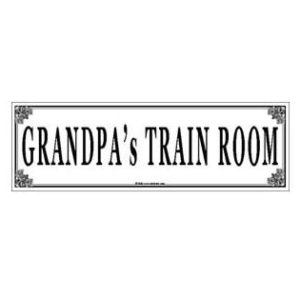A tin sign featuring the Boston & Maine Railroad steam locomotive No. 3713, known as the “Constitution”. She is being restored to her glory days at “Steamtown National Historic Site” in Scranton, PA. Metal measures 10″ x 12″, with rounded corners and an 1/8″ hole punched in each corner. Metal is .025 gauge aluminum.
Share your favorite signs from MrTrain.com with your friends at Pinterest.
*Check out our other Railroad Signs
The Boston and Maine Corporation, known as the Boston and Maine Railroad, was a U.S. Class I railroad in northern New England. It became part of what is now the Pan Am Railways network in 1983. At the end of 1970, B&M operated 1,515 route-miles on 2,481 miles of track, not including Springfield Terminal.
The invention of the steam railroad in the 19th Century radically expanded human mobility and commerce. By “annihilating distance” the railroad forever changed the American landscape and patterns of business and domestic life. Originating in the idea of constructing a continuous inland route between Boston and Portland, the Boston and Maine Railroad gradually gained control of other lines until the B&M system linked hundreds of cities, towns, and villages in Massachusetts, Maine, New Hampshire, Vermont, and New York.
Shipments of grain, ice, lumber, meat and produce over its rails contributed to the expansion of Boston as a market center and a great seaport. The B&M and its predecessor companies made possible the development of New England’s manufacturing cities and eliminated the crushing isolation of life in the country. For most communities it became the link to the outside world. It also found markets for the products of each town’s industry and in return brought to every locality the whole range and variety of goods that were the fruit of the Industrial Revolution.
The Boston and Maine Railroad was the successor to the Andover and Wilmington Railroad which opened in 1836. Over the next 65 years the B&M gained control (through lease, purchase, or stock ownership) of the Eastern, Boston and Lowell, Connecticut and Passumpsic Rivers, Concord & Montreal, Connecticut River, Fitchburg, Portland and Rochester, and Worcester and Nashua railroads, most of which themselves were agglomerations of shorter, earlier roads. All had their main lines and branches that wove a tight web of steel through northern Massachusetts, southern Maine, the state of New Hampshire, and eastern New York and Vermont. At its peak B&M maintained over 2,300 route miles of track, 1,200 steam locomotives, and a force of 28,000 employees. The road’s principal shops were located at North Billerica, Mass. and Concord, N.H. Major freight yards were built at Boston, East Deerfield, Rigby, and Mechanicville.






Reviews
There are no reviews yet.